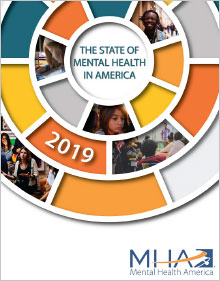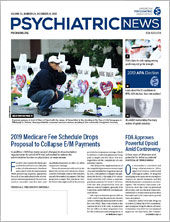The states that ranked highest overall on access to mental health care—with the lowest prevalence of mental illness—were Minnesota, Maine, Massachusetts, New Jersey, and Vermont, according to the “State of Mental Health in America 2019” report by Mental Health America (MHA).
States were assigned an overall mental health ranking based on 15 measures involving prevalence of mental illness, including serious thoughts of suicide and substance use disorder, and access to care, including health insurance status, mental health coverage, and mental health workforce availability.
The state that ranked lowest was Nevada, followed by Idaho, Oregon, Mississippi, and Alaska.
Now in its fifth year, the annual report provides a snapshot of mental health status and access to care among youth and adults and monitors trends. The report analyzes national survey results from all 50 states and the District of Columbia from the Substance Abuse and Mental Health Services Administration, Centers for Disease Control and Prevention, as well as other state and federal sources.
The report also ranked states based on their availability of “mental health providers,” defined as psychiatrists, psychologists, social workers, counselors, marriage/family therapists, and advanced practice nurses specializing in mental health care. In the top-ranked states, the ratio of state residents to mental health providers was close to 200 to 1 (Massachusetts, District of Columbia, Maine, Oregon, and Vermont), but in the lowest-ranked states there were at least four to six times as many residents for every provider (Alabama, Texas, West Virginia, Georgia, and Arizona).
The shortage of mental health providers has resulted in many individuals not accessing care or relying on emergency room services for psychiatric care. More than half of psychiatrists will reach retirement age within seven years, which could exacerbate the shortage if many of them decide to retire.
“Integrating primary care and behavioral health services is key for early identification and intervention but is only part of the solution. Primary care providers cannot fill the void created by a lack of psychiatrists,” the MHA report noted.
Twenty percent of adults with any mental illness were not able to receive the treatment they needed, and this number has not declined since 2011, MHA reported. Some barriers included cost of care, lack of insurance or limited coverage of mental health services, and a shortage of mental health providers.
The report showed alarming increases in serious suicidal ideation among adults and major depression among youth. The number of adults reporting serious thoughts of suicide was more than 9.8 million (4 percent nationwide) this year, an increase of 200,000 people since 2017. Among young people, nearly 13 percent of youth had at least one past-year major depressive episode, up from 9 percent in 2017.
“Despite mental health being something that more and more people are talking about, far too many people are still suffering,” said Paul Gionfriddo, MHA president and CEO. “People are simply not receiving the treatment they need to live healthy and productive lives—and too many don’t see a way out.”
When it comes to unmet mental health needs, there was a wide disparity between the highest ranked states (Hawaii, Alabama, Texas, Nebraska, and Maine), where nearly 16 percent to 17 percent of adults reported unmet mental health care needs, and the lowest ranked states (Nevada, New Hampshire, Oregon, and Idaho) and the District of Columbia, where 25 percent to 26 percent did not receive needed services.
The report also uncovered some good news: Under the Affordable Care Act, the U.S. continues to see a decline in the number of Americans who are uninsured, with a nearly 3 percent reduction from last year. In fact, 46 states reported a reduction in the number of adults with any mental illness who lack insurance. The largest reductions were seen in South Carolina, Missouri, Arkansas, and Arizona, all of which had a 6 percent to 7 percent decline in adults with mental illness who had no insurance coverage.
Youth with mental illness seemed to fare far worse than adults when it came to access to care: Close to two-thirds of youth with major depression (62 percent) did not receive any mental health treatment, MHA reported. Only one-quarter of youth with severe depression receive consistent treatment, defined as seven to 21 visits in a year. Late recognition of mental illness in primary care settings and limited coverage of mental health services often prevent youth from receiving timely and effective treatment.
Nationwide, less than 1 percent of students (0.8) were identified as having an Individual Education Program (IEP) for emotional disturbance (ED). “If states were doing a better job of identifying whether youth had emotional difficulties that could be better supported through an IEP, the average rate would be closer to 8 percent instead of 0.8 percent,” MHA wrote. “Early identification for IEPs is critical. IEPs provide the services and support students with ED need to receive a high-quality education.” The top five states (Vermont, Minnesota, Massachusetts, Wisconsin, and Pennsylvania) identified 15 students to 27 students per 1,000 as having an IEP for ED, and the lowest-performing five states (Alabama, Arkansas, Louisiana, Utah, South Carolina) identified 2 students to 4 students per 1,000.■
The report, “The State of Mental Health in America 2019,” can be accessed
here.

